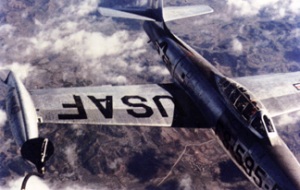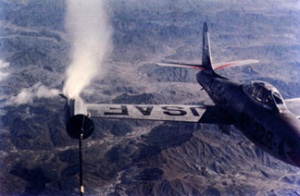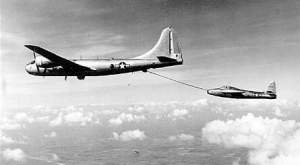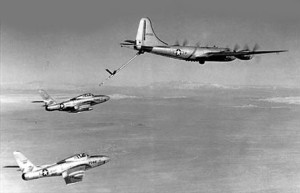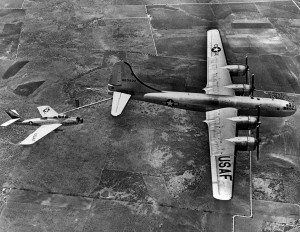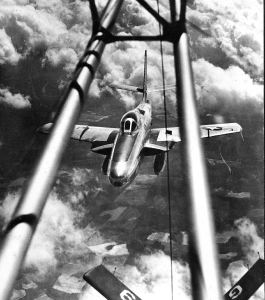KC-97 Refueling F-84 Thunderjets
Great video with a scene showing the F-84’s receptacle pop up from the left wing.
KC-97G 52-2718
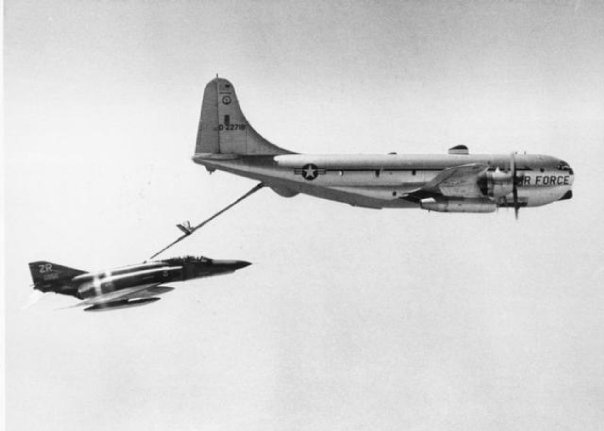
A KC-97G refuels a F-4 Phantom. The high deck angle of the F-4 is indicative of the low refueling speed.
During Operation Creek Party (out of Rhain MAin AB). The Recon Rhino shows the tailcode of Zweibrücken Air Base, Germany. RF-4C 68-0556 was w/o 8 June 1983 while based at RAF Alconbury U.K. The 126 ARS operated KC-97F from August 1961 and the KC-97L from March 1965. They went to KC-135A in December 1977.
Image Source:
Kevin Kearney
B-47 refueling from KC-97L
This is the refueling scene from the movie “Strategic Air Command”. In this scene a B-47 is refueled from a KC-97L. The KC-97L is easily identified by the addition of two J-47 turbojet engines under the wings outboard of the R-4360 radials. The J-47s gave the KC-97 a higher top speed which allowed it to refuel the new breed of high speed jet powered aircraft. The KC-97L was a stopgap measure until the KC-135A Stratotanker came online.
Video Source:
Experimenting with jet refueling – Multiple F-84 refueling configurations
By the late 1940s and early 1950s, air refueling had been around in an experimental capacity for nearly 30 years. With the end of the Second World War and the inception of the Cold War, air refueling was seen as a vital technology that had to be further developed so that fuel hungry jet aircraft would have the range and endurance required to perform their required missions. The F-84 Thunderjet existed during this time of air refueling development and refinement; therefore it saw numerous configurations that included multiple drogue and receptacle variants. One of the more interesting configurations tested was a dual probe system that required the F-84 to refuel each of its wingtip mounted tanks with a separate probe that was integral to each tank. This highly offset design made it difficult for the receiver pilot to accurately make contact with the tanker’s drogue. The distance from aircraft centerline meant that the pilot would have to look sideways to align the probe with the drogue. During this time he would have to use his peripheral vision to fly formation off of the tanker. Complicating matters was the fact that any roll would be magnified at the wingtip.
Another drogue refueling method employed by later model F-84s was a single point refueling probe. The probe was located on the left side of the forward fuselage. This positioning made it much easier for the pilot to see the probe while still being able to fly formation off of the tanker. This design has proved to be the best positioning for refueling probes, and aircraft today still feature their probes in a similar position with respect to the pilot.
A third refueling system that can be found on the F-84 is a boom receptacle installed on the upper surface of the left wing. This design allowed an equipped F-84 to receive fuel from a boom tanker. The boom method of refueling lowered the receiver pilot’s workload because all he had to do was fly into the air refueling envelope after which the tanker’s boom operator could precisely place the nozzle into the receptacle. The rigid flying boom also provides a certain amount of stability (especially to small and lightweight aircraft like the F-84) between the two aircraft by resisting forward and aft motion. The receiver aircraft is still free to move for and aft in the envelope, but must first exceed pressure relief valves in the boom’s retract mechanism.
Dual Wingtip Tank Refueling
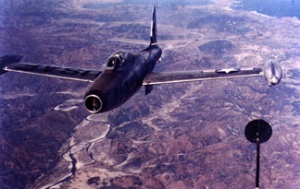
An F-84 aligning with the drogue. Notice how far off center the pilot must look to line up the probe with the basket. Any turbulence would make this essentially impossible.
Single Point Probe
Boom and Receptacle
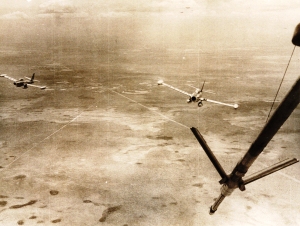
High over West Texas, two F-84Gs of the 31st Fighter Escort Wing pull in behind a waiting KB-29P during Operation Fox Peter One. Note the opened receptacle on the upper surface of the left wing.
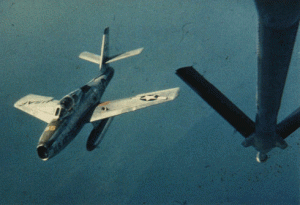
An F-84 banks off to the right after refueling from a KC-97. Note the opened receptacle and drop tanks.
KC-97 Video Tour
Here are a couple of videos that show the interior of the KC-97 including a brief view of the boom pod.
Video Source:
Video tour of a KC-97L
Unfortunately this wonderful video has been removed from YouTube.
Here is a video tour of the exterior and interior of a KC-97L at the AMC Museum at Dover AFB, DE. If you visit the youtube page directly you can watch the video in high definition.
Video Source:
KC-97 Boom
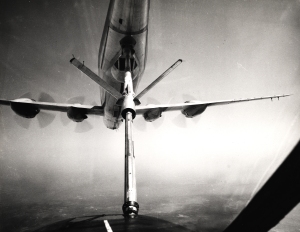
This receiver aircraft pilot's-eye view of an inflight refueling operation provides an excellent view of the flying boom and the boomer pod on the underside of the KC-97 tanker. Click image to enlarge
This is the view of a receiver pilot taking gas from a KC-97. I am not sure of the receiver type, but it might be a B-47.
Image Source:
A-10 Refueling From a KC-97L

Two Fairchild Republic A-10As refuel with a Boeing KC-97L Stratotanker (S/N 53-355) of the Texas Air National Guard. (U.S. Air Force photo) Click image to enlarge.
In this picture a pair of Fairchild A-10As are being refueled by a KC-97L. I am unaware of the exact date of this picture, but the A-10 first flew on 10 May 1972 and the KC-97 was retired in 1978 so the picture must have been taken somewhere in that window.
The Strategic Air Command took delivery of its first KC-97 on 14 July 1951. The main production version of the KC-97 was the KC-97G of which 592 were built. By 1958 SAC operated 780 KC-97s, but the 1957 introduction of the KC-135 meant that the -97s days were numbered. The piston powered KC-97 was too slow for the new generation of fighters and too small for the newly introduced B-52. The KC-135 was an all new design that was more than fast enough to keep up with the fighters and had sufficient offload to support the B-52. In 1958 SAC began to decommission its KC-97 fleet.
In April of 1961 the Air National Guard received its first KC-97 from SAC. The mission of the KC-97 under the guard was to refuel the Tactical Air Command’s fighters. During refueling with fighters the KC-97 was required to fly as fast as possible while its receiver flew on the edge of a stall. Often times the refueling had to be conducted in a shallow dive (toboggan) so that the tanker could maintain a minimum speed required by the fighter. Surplus General Electric J47 jet engines were available from decommissioned KB-50 tankers and they were added under the wings of the KC-97E/Fs. The upgraded aircraft was redesigned the KC-97L. Each J47 produced 5,800 lbs of thrust which drastically increased the performance of the KC-97 and gave it enough extra speed to keep up with fighters of the day.
Just as the KC-97 was too slow for fighters of the day, the KC-135 was too fast for the A-10. Refueling between a heavily laden A-10 and KC-135 produced a situation where the A-10 did not have enough thrust to fly at the KC-135’s minimum flying speed. When refueling A-10s, the KC-135 was limited to a maximum gross weight of 250,000 lbs and even then it was often required to lower its flaps to 20º or 30º. The KC-97L and A-10 were a perfect match due to their similar flying speeds.
Sources:
- http://books.google.com/books?id=C04zANFFmzgC&pg=PA58&dq=kc-97l&as_brr=3&ei=OBoHSo6zI4vKNdv-tYUC#PPA56,M1
- KC-97 Stratotanker. (2009, April 19). In Wikipedia, The Free Encyclopedia. Retrieved 19:12, May 10, 2009, from http://en.wikipedia.org/w/index.php?title=KC-97_Stratotanker&oldid=284815953
Image Source:
KC-97Gs refueling F-100Ds
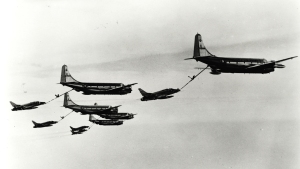
In August 1964 these former Strategic Air Command KC-97Gs -- by then assigned to the Illinois Air National Guard's 126th Air Refueling Wing out of O'Hare International Airport -- refueled Air National Guard F-100D Super Sabres in the first non-stop trans-Atlantic deployment of guard fighters to Europe (U.S. Air Force photo) Click image to enlarge.
In this picture depicting a coronet operation, probe equipped F-100Ds are being refueled by a formation of KC-97Gs. This exercise was one of many that helped prove the speed at which TAC fighters could be deployed with the help of SACs tanker fleet. Note the nose high attitude of the F-100s which helps illustrate the incompatibility of the KC-97 and fighters.
